Bulletin – June 2010 Demography and Growth
- Download the article 339KB
Abstract
Substantial demographic shifts are under way in many countries which could have a sizeable impact on trend growth rates over coming decades. This article explores some of these demographic developments, particularly in relation to population growth and age structure, for a range of economies. It also examines some of the direct effects that these changes could have on average growth over the next 10 years.
Introduction
Demographic change can have profound effects on a country's economy and public finances. These effects generally manifest themselves over multi-decade periods, but the deterioration in many countries' public finances and concerns about their underlying growth potential have recently brought demographic issues to the fore. Against this background, this article reviews the medium-term demographic changes projected to occur in a range of economies – the United States, Japan, Germany and Italy, along with China, India, Mexico, Korea, Indonesia and ‘east Asia (excluding China and Japan)’.[1] These countries are either important to Australia as trading partners or illustrate the various demographic challenges now facing different economies. The article then sets out the key channels through which demography influences countries' trend growth rates, and quantifies in broad terms the scale of the likely direct impact of demographic developments over the next decade.[2]
Projected Demographic Developments
The demographic data used in this article are taken from the 2008 Revision of the UN's World Population Prospects, adopting the central scenarios for the population projections for each country (as opposed to the high- and low-fertility variants).[3] These central scenarios assume a continuation of recent patterns and policies on migration in each nation – so that the possibility of substantial shifts in migration trends should be thought of as a key caveat to the analysis presented here.[4]
At a global level, steep declines in fertility rates have seen world population growth fall from an annual rate of 2 per cent in the 1970s to around 1.2 per cent today, largely reflecting the tendency for family size to decline with improvements in living standards (Graph 1). Although long-term projections are subject to considerable uncertainty, world population is now forecast to peak in the second half of this century, at somewhat over 9 billion, before starting to decline.
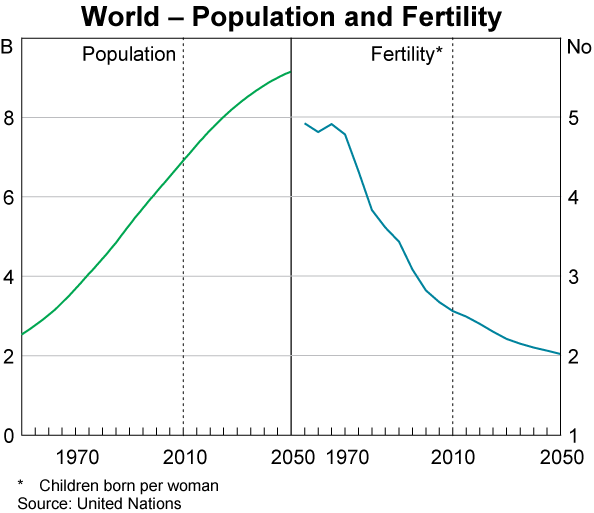
These global data, however, mask notable differences in demographic developments at a national level (Graph 2). In Europe, fertility rates in many countries have, for some time, been far below the level consistent with a stable population in the long run (absent net immigration), and population has already started to decline in Germany. A range of countries in Asia are also expected to see population declines and significant population ageing in the foreseeable future. For example, China's population is projected to peak in around 20 years' time at just under 1½ billion, before slowly contracting. In Korea, the population is expected both to peak earlier (around 2020) and thereafter to fall more noticeably; and in Japan the population has already started to turn down and, absent a major change in birth rates or immigration, appears poised to experience an almost unprecedented peace-time decline of around 20 per cent over the next four decades. In contrast, population continues to rise rapidly in Indonesia and India, with the latter expected to overtake China as the world's most populous nation in around 2030.
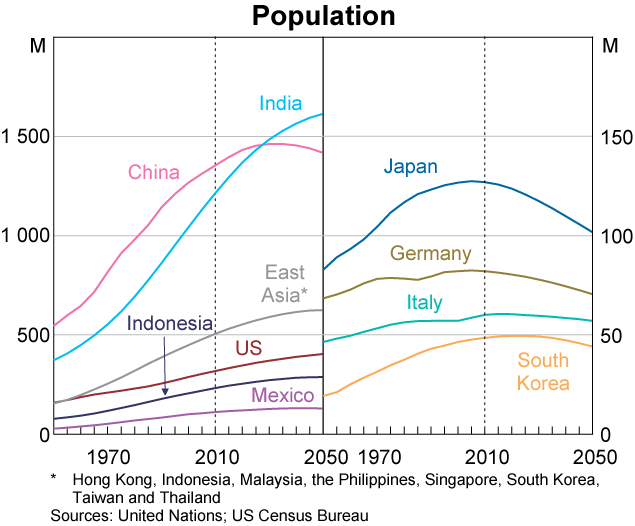
Besides population, another summary indicator of demographic trends, capturing changes in a country's age structure, is the dependency ratio – the non-working-age population expressed as a percentage of the working-age population (defined here as those aged 15 to 64). In many countries the dependency ratio rose through the 1950s and then fell steeply through the late 1960s, 1970s and 1980s, with the exact timing varying by country (Graph 3). While these declines were sizeable in the United States, Germany and Italy, they were much larger again in China, Indonesia, Korea and Mexico – with China also experiencing a further marked step-down in its dependency ratio over the past 15 years. In all countries except India, however, this situation is expected to reverse over the next four decades – in some cases very sharply (Japan, Korea, Germany, Italy) – with dependency ratios projected to rise to form the second half of the rough ‘U’-shape evident for most countries.
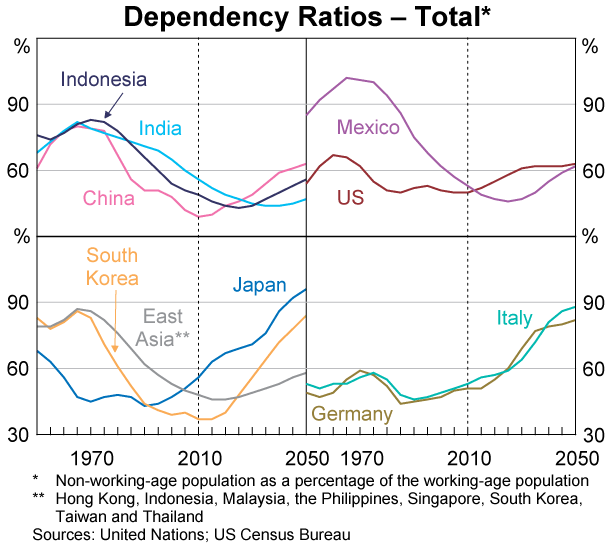
These ‘U’-shapes generally reflect the gradual ageing of the population following the post-War baby boom. This boom resulted in high youth dependency in most countries through the 1950s and 1960s, but falling birth rates then saw plummeting youth dependency, which in turn drove down overall dependency ratios (Graph 4). This situation is now reversing, as the post-War generation enters retirement, rapidly lifting aged dependency ratios in most economies.
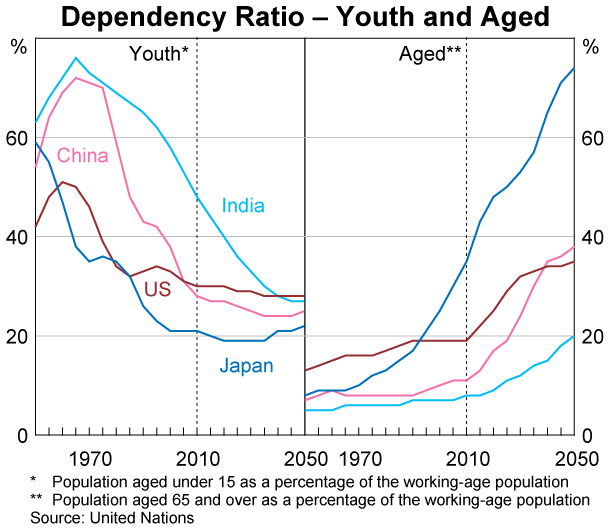
Of course, implicit in the terminology ‘dependency ratio’ is that age 65 represents a suitable threshold for judging when individuals should cease to be viewed as ‘working age’, and instead become ‘dependants’. Whether this will continue to be so is an important issue. In this context, it is notable that various countries have already taken steps to mitigate some of the impact of rising aged dependency, through gradual increases in the pension age.
A further aspect of rising dependency ratios is the extent to which these reflect projected increases in the proportion of very elderly people in the population. In many European nations, with life expectancy continuing to rise and low birth rates for the past several decades, the ‘very old age dependency ratio’ – those aged 80 and over as a percentage of the working-age population – is anticipated to pick up sharply (Graph 5). The same is true for Japan and Korea, with the rapid increase phase for this ratio already well under way in Japan. By contrast, in the United States the rise in the very old age dependency ratio is projected to be more gradual (albeit still substantial), while in India and Indonesia little increase in this ratio is expected for the foreseeable future.

Quantifying the Impact of Demography on Growth
Demography has both direct and indirect effects on a country's GDP growth. The main focus in the following is on the direct impacts, although there is also a brief discussion of some of the potential indirect effects.
Principal direct effects of demography on growth
Annual output growth can be decomposed into the sum of growth in total labour input and labour productivity growth. Demographic change directly influences growth through its impact on the first of these factors, which can itself be broken down into three components:[5]
- population growth;
- growth in the working-age share of the population; and
- changes in the participation rate of those of working age.
Graph 6 illustrates that population growth is already detracting from GDP growth in Japan and Germany. In both China and Korea it is expected to begin doing so in the foreseeable future, after contributing strongly to growth in both cases for much of the latter part of the last century. For the United States, by contrast, population growth is projected to continue to contribute solidly to GDP growth, reflecting ongoing high net immigration (in part from Mexico, where net migration is correspondingly negative). In India, population growth – although gradually slowing – is forecast to exceed 0.7 per cent per annum on average over the next four decades, despite negligible net migration.
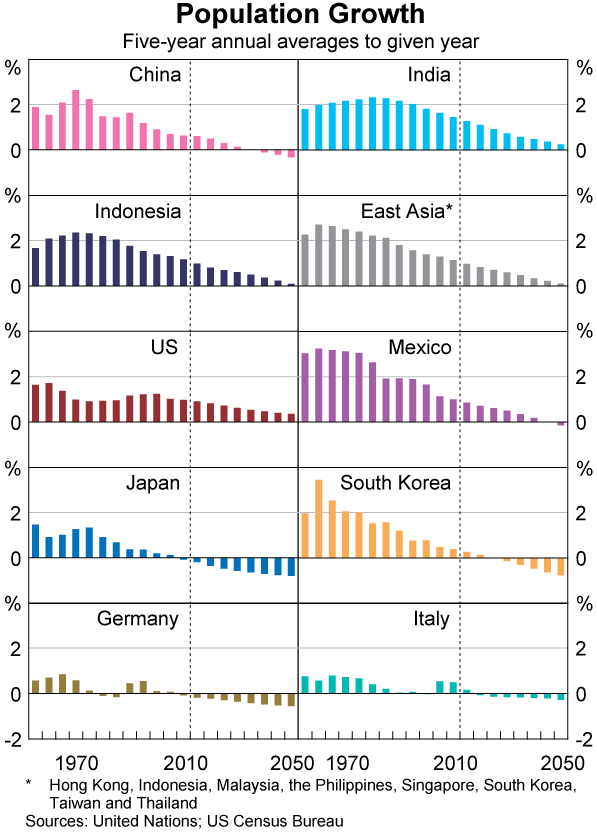
Turning to the impact on trend growth from shifts in the working-age share of the population – that is, from compositional change in population structure – Graph 7 illustrates that within 10 years this impact is projected to turn negative in most of the economies considered, if it has not already done so. For Korea, the change over time in this compositional effect on growth is especially striking; in the 1970s and 1980s this factor was contributing 1–1½ percentage points to annual GDP growth, whereas by the mid 2020s it is projected to be subtracting a full percentage point.
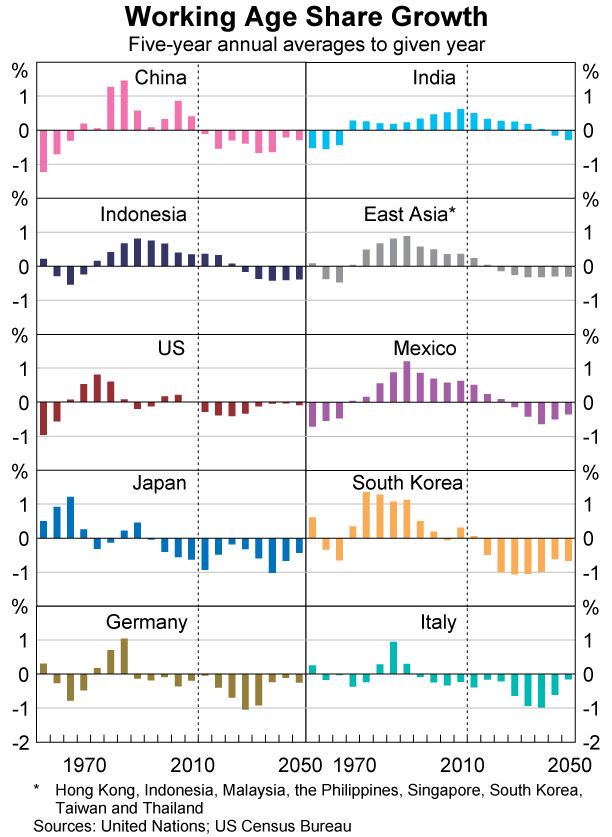
Finally, these reductions in trend growth rates could be mitigated to some degree by increases in labour force participation (the third factor listed above). Comparing male and female participation rates, for most of the economies considered there may be scope for GDP to be raised by increasing female participation.[6] For example, while the female participation rate in the United States is around 60 per cent – not substantially different from the rate for males of just over 70 per cent – it is around 50 per cent in Germany, Korea and Japan, and just 40 per cent in Italy. However, since it is unclear how demographic developments might influence aggregate participation rates in different countries over coming decades, no attempt is made here to quantify the impact of this third factor on either historical or prospective annual output growth.
Quantifying the direct impact of changes in population growth and structure
It is possible to combine the impact of the first two direct effects of demographic change, population growth and growth in the working-age population share, to obtain estimates for the potential direct impact of demography on trend growth over the coming decade, relative to the recent past (Tables 1 and 2). The comparison period 1996–2005 is used because it precedes the recent major global downturn, the impact of which is still playing out, while representing a reasonable baseline period for assessing trend growth.
As Table 1 shows, demographic factors were already subtracting from growth in Japan and Germany in the decade 1996–2005, compared with a large positive annual contribution of around 1¼ percentage points in the United States. Indeed, once this direct demographic effect is stripped out, the adjusted average annual growth rates of all four advanced economies, over these 10 years, were within 0.6 percentage points of each other. Excluding the United States they were even closer – within 0.1 percentage points of each other – with average growth in Japan fractionally higher than in Germany and Italy. This provides an interesting perspective on the ongoing debate about the ‘lost decade’ for the Japanese economy.
| US | Japan | Germany | Italy | |
|---|---|---|---|---|
| Baseline period 1996–2005 | ||||
| Average annual real GDP growth | 3.3 | 1.1 | 1.3 | 1.4 |
| Total direct contribution from demography | 1.3 | −0.3 | −0.1 | 0.0 |
| Contribution from population growth | 1.1 | 0.2 | 0.1 | 0.2 |
| Contribution from growth in the working-age share | 0.2 | −0.5 | −0.2 | −0.3 |
| Memo item: average growth adjusted for demographic change | 2.0 | 1.5 | 1.4 | 1.4 |
| Impact of demographic change 2011–2020 | ||||
| Expected contribution to annual growth from demography | 0.5 | −1.0 | −0.4 | −0.2 |
| Contribution from population growth | 0.9 | −0.3 | −0.2 | 0.1 |
| Contribution from growth in the working-age share | −0.3 | −0.7 | −0.2 | −0.3 |
| Change in direct demographic contribution to growth | −0.8 | −0.6 | −0.3 | −0.2 |
|
Sources: RBA; Thomson Reuters; United Nations |
||||
It is also notable that correcting for shifts in the working-age share of the population makes these adjusted growth rates much closer than simply correcting for population growth. For example, average annual growth rates for the United States and Japan over the decade 1996–2005 were closer in per capita terms (2.2 per cent versus 1.0 per cent) than in headline terms (3.3 per cent versus 1.1 per cent). However, they were much closer again (2.0 per cent versus 1.5 per cent) after also adjusting for changes in population structure over this period, through a working-age share correction.
For the decade ahead, changes in demography are expected to directly lower growth by the largest amount, relative to the 1996–2005 period, in the United States, where they may shave 0.8 percentage points off average annual GDP growth. In Japan, the negative impact is anticipated to be almost as large (0.6 percentage points), while in Germany and Italy it is likely to be somewhat smaller.[7]
Turning to Table 2, demographic change is projected to directly lower underlying GDP growth in China over the next decade by more than in any of the other economies considered – subtracting around 1¼ percentage points from average annual growth relative to the period 1996–2005 (with ¼ percentage points of this due to slower population growth, and 1 percentage point due to a decline in growth of the working-age share of the population). In India and Mexico the downward impact on annual trend growth from demographic change is expected to be smaller but still significant. Nevertheless, in both cases the direct contribution to growth from demography is projected to remain solidly positive over the coming decade (exceeding 1½ percentage points per annum in India).
| China | India | Mexico | |
|---|---|---|---|
| Baseline period 1996–2005 | |||
| Average annual real GDP growth | 8.8 | 6.5 | 3.7 |
| Total direct contribution from demography | 1.4 | 2.2 | 2.1 |
| Contribution from population growth | 0.8 | 1.7 | 1.4 |
| Contribution from growth in the working-age share | 0.6 | 0.5 | 0.6 |
| Memo item: average growth adjusted for demographic change | 7.3 | 4.2 | 1.6 |
| Impact of demographic change 2011–2020 | |||
| Expected contribution to annual growth from demography | 0.2 | 1.6 | 1.1 |
| Contribution from population growth | 0.6 | 1.2 | 0.7 |
| Contribution from growth in the working-age share | −0.3 | 0.4 | 0.4 |
| Change in direct demographic contribution to growth | −1.2 | −0.6 | −1.0 |
| South Korea | Indonesia | East Asia(a) | |
| Baseline period 1996–2005 | |||
| Average annual real GDP growth | 4.4 | 2.7 | 4.0 |
| Total direct contribution from demography | 0.7 | 1.9 | 1.8 |
| Contribution from population growth | 0.6 | 1.4 | 1.4 |
| Contribution from growth in the working-age share | 0.1 | 0.5 | 0.4 |
| Memo item: average growth adjusted for demographic change | 3.6 | 0.8 | 2.2 |
| Impact of demographic change 2011–2020 | |||
| Expected contribution to annual growth from demography | 0.0 | 1.2 | 1.0 |
| Contribution from population growth | 0.2 | 0.9 | 0.9 |
| Contribution from growth in the working-age share | −0.2 | 0.3 | 0.1 |
| Change in direct demographic contribution to growth | −0.7 | −0.6 | −0.7 |
|
(a) Hong Kong, Indonesia, Malaysia, the Philippines, Singapore, South Korea, Taiwan and Thailand Sources: CEIC; RBA; Thomson Reuters; United Nations; US Census Bureau |
|||
As for the other east Asian economies, at an aggregate level demographic factors directly accounted for a sizeable fraction of average growth in the region over the baseline period 1996–2005, contributing almost half of the annual growth recorded over this decade. Indeed, population growth was nearly 1½ per cent for the region as a whole and exceeded 2 per cent per annum in Singapore, Malaysia and the Philippines; while changes in the working-age share of the population separately added around ½ percentage points to annual growth in each of the ASEAN-4 countries (and a smaller amount in the higher-income Asian economies).
Looking ahead, Table 2 shows that in Korea the ageing of the population is projected to directly reduce trend growth between 1996–2005 and 2011–2020 by around ¾ percentage points (after already subtracting a full 2 percentage points between 1976 –1985 and 1996–2005). Demographic change is also expected to have a broadly similar negative impact on trend growth in the east Asia bloc as a whole.
Finally, it is notable that the slowing in trend growth due to demographic factors is expected to be greater over the next decade in all of the economies considered in Table 2 than in either of the European countries in Table 1. This chiefly reflects that the direct contribution from demography to growth was already much lower in Germany and Italy, in the baseline period, than in these other economies.
Potential indirect effects of demography on growth
There are a number of other ways in which shifts in demography or labour force participation
might alter countries' trend GDP growth rates. As noted earlier, one
which would boost average growth at the margin would be an increasing propensity
to remain in work among those aged 65 and over. In 2005, the participation
rate among this age group was only 3 per cent in Italy, compared with
over 15 per cent in the United States, 20 per cent in
Japan and around 30 per cent in Korea.
It is also possible that demographic change could influence growth through altering the propensity for societies to innovate and take risks. On the one hand, younger societies could be more dynamic and entrepreneurial than older ones. On average, people in their twenties or thirties may feel more inclined than older people to start a new business or stake their savings on developing an innovative new product, given their greater time until planned retirement and lesser exposure to the challenges involved in establishing a successful business. Hence, the ongoing rise in the median age of the population in most countries could result in slower average productivity growth (Graph 8). On the other hand, by generating upward pressure on the cost of labour relative to capital due to growing scarcity of available workers, population ageing could increase the pressure for firms to innovate, as a way of controlling costs.[8]
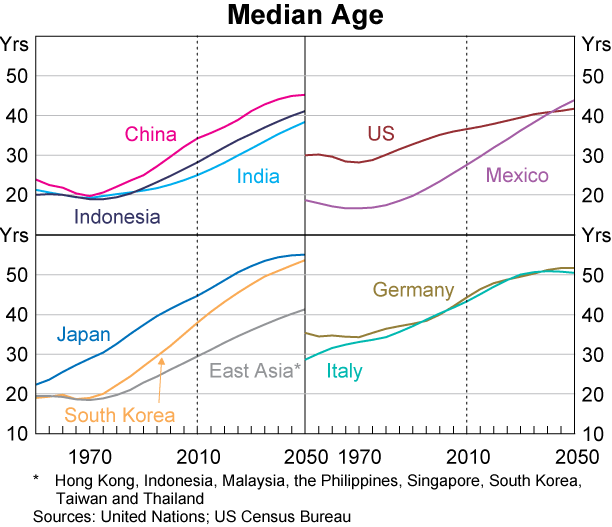
Finally, some aspects of the interaction between demography and financial markets could also act to dampen average growth in countries with ageing populations. For example, if a country's population were projected to decline, with the share of adults of typical household-forming age also projected to fall, this might be expected over time to weigh on demand both for housing and for riskier financial products such as equities or corporate bonds relative to government bonds. If so, then to differing degrees across different asset markets, these expectations could become incorporated into both current asset prices and anticipated asset price growth, potentially depressing near-term aggregate demand and output growth through wealth effects and disincentives to invest.[9]
Conclusion
Substantial demographic shifts are under way in many countries which could have a sizeable influence on trend growth rates over coming decades. In particular:
- Many countries can expect to see a noticeable step-down in trend GDP growth in the decade 2011–2020 (measured relative to the decade 1996–2005) due to the direct impact of demographic change. This reduction in annual trend growth is projected to exceed ½ percentage points in many countries, with China expected to experience a particularly pronounced reduction of around 1¼ percentage points.
- While population ageing is most commonly associated with various European nations and Japan, a number of other east Asian economies are following similar demographic trajectories, just a decade or two later. All other things equal, the impact of slowing population growth and diminishing expansion in the working-age population share could lower trend growth in east Asia (excluding China and Japan) by almost 1 percentage point over the decade 2011–2020, relative to the period 1996–2005.[10]
- In contrast to the situation in many east Asian economies, population continues to rise rapidly in Indonesia and India, with India expected to overtake China as the world's most populous nation in around 20 years' time.
Footnotes
The authors are from Economic Analysis Department. [*]
In addition to Korea and Indonesia, this latter bloc includes Hong Kong, Malaysia, the Philippines, Singapore, Taiwan and Thailand. [1]
While the graphs in this article generally extend to 2050, the focus in the analysis is on the next decade. This reflects that, absent significant changes in net migration patterns, considerable reliance can be placed on demographic projections of working-age population growth over a 10-year horizon, since all those who will enter the working-age cohort by 2020 have already been born. [2]
See <http://esa.un.org/unpp/> and UN (2009). Data for Taiwan are sourced from the US Census Bureau's International Data Base. [3]
Recent developments in Australia illustrate how large an impact shifts in migration numbers can have on projections of labour force and output growth, as discussed in RBA (2009). [4]
This decomposition ignores cyclical influences such as fluctuations in the unemployment rate (consistent with a focus on assessing long-run average growth). It also abstracts from trend changes in average hours worked (where the influence of demography, if any, is unclear), and from changes in the labour input of those aged under 15 or over 64 (non-working age). [5]
This observation abstracts from the accounting issue of unpaid work in the home not being counted as part of GDP. National statisticians adopt this approach because of the difficulty of accurately measuring such output, and the need to set a ‘production boundary’ for what is and is not included in GDP. However, it almost certainly results in the impact on measured GDP from stay-at-home parents entering the workforce being greater than the true impact on output. [6]
As a result, if average growth in the GDP deflator and in labour productivity were to be the same in each country over the coming decade as over the period 1996–2005, even nominal GDP might be expected to decline over the next 10 years in Japan, which would complicate the task of repairing that nation's public finances. [7]
See Kent, Kulish and Smith (2006). [8]
See RBA (2006). [9]
This calculation makes allowance for the fact that the projected decline in growth in the working-age population in east Asia over the coming decade is generally more pronounced in those economies with high labour productivity than in those economies where the level of labour productivity is lower. [10]
References
Kent C, M Kulish and K Smith (2006), Ageing, Retirement and Savings: A General Equilibrium Analysis, RBA Research Discussion Paper No 2006-06.
RBA (Reserve Bank of Australia) (2006), Demography and Financial Markets, Proceedings of a Conference, Reserve Bank of Australia, Sydney.
RBA (2009), ‘Box F: Growth in the Factors of Production’, Statement on Monetary Policy, November, pp 75–76.
UN (United Nations) (2009), World Population Prospects: The 2008 Revision – Highlights, United Nations, New York.